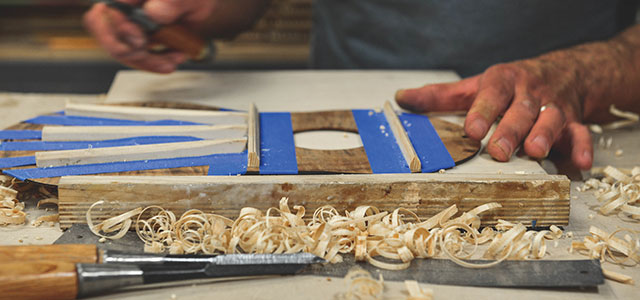
The popularity of individual musical instruments tends to be cyclical, with “hot” periods sometimes being measured in years and sometimes being measured in decades. For the past half-dozen years or more, the ukulele has enjoyed a renaissance in popularity that’s been driven not only by the instrument’s relative easiness to learn, but also by the high-quality models (at affordable prices) that our industry’s manufacturers have created.
Petaluma CA-based Kala Brand Music Co., founded in 2005 and continuing to grow healthily, exemplifies the segment’s strength. According to Dave Cafiero, Vice President of Sales & Operations, “As the brand leader and the largest ukulele maker in the world, we’ve actually expanded the ukulele category. This has benefited our competition, and it’s made the ukulele one of the best-selling items in the music industry.” In addition to expanding Kala Brand’s dealer network aggressively, the company’s also broadened its product portfolio and its price-point range, ensuring every player can make music with a Kala instrument. In recent months, no product has gained more attention—or greater acclaim—than the 2016 collection of the company’s Elite Ukulele Series.
The complete 2016 Elite Series, which is two years in the making, is composed of three models: the 1KOA, 2KOA and 3KOA, each available in soprano, concert and tenor sizes. “Initially, we spent four months apprenticing with Michael DaSilva at his shop in Berkeley CA,” Head of Manufacturing Jason Villa stated, “learning all aspects of crafting high-end ukuleles.” Throughout that period, the production team also visited and learned from talented luthiers like Bob Gleason (Pegasus Guitars & Ukuleles), Noa Bonk (Ko’olau Guitars & Ukuleles), Casey Kamaka (Kamaka Ukulele) and Eric Smith (National Guitars). Taylors Guitars, too, was a constant source of information, help and encouragement. “We experimented quite a bit with different construction methods, bracing patterns and materials,” Villa added, testifying to the spirit of innovation that Kala brought to the project.
Manufacturing Supervisor and Custom Build Expert Liam Jenkins explained, “As we worked our way through the building of each prototype, we developed the tools and fixtures necessary to make the instruments on a production level.” He added that Manufacturing Engineer Clark Rector worked hard to design the instrument components, fixturing and tooling in 3D CAD software so that everything could be built using CNC and laser machines, ensuring quality, repeatability and consistency. He continued, “A big part of our shop culture is the concept of lean manufacturing. Each day, we seek to eliminate waste and improve efficiency in our manufacturing processes.”

Each Elite Series model boasts an all-solid Hawaiian koa top, back and sides, along with a Honduran mahogany neck, and each offers its own distinct, striking wood pattern. Indeed, according to President/Owner Mike Upton, the instruments were designed so that the figure of the wood would be the standout feature. “On some of our 3KOA instruments, you will see what is called fiddleback on the top, back and sides,” he said. “Other instruments contain very striking grain patterns that resemble tiger stripes.” The amount of figuring, as well as the forward visibility of the features, differentiates the models from one another, with the figuring increasing from the 1KOA to the 3KOA. Another design feature is the 3KOA’s use of ebony for the headplate, fretboard and bridge. The 1KOA and 2KOA ukes, meanwhile, use Indian rosewood for those parts. Sonically, the 1KOA and 2KOA are a bit warmer sounding, whereas the 3KOA is slightly brighter.
The 1KOA is available in both satin and high-gloss, whereas the 2KOA and 3KOA are available in high-gloss exclusively. “We use UV-cured polyester finishing for both our satin and gloss instruments,” Villa stated. “UV curing our finishes has many tremendous benefits.” Because the finish cures within minutes, it allows Kala Brand to move its instruments through the production line without them having to cure for several weeks. And, once it’s been cured, sanded and buffed, the finish is incredibly thin and durable. “This benefits the sound of our ukes, because it’s widely known that thin finishes are one of the factors to achieve good tone,” Jenkins added. Finally, UV-cured finishes are environmentally friendly, because almost all the finish material goes onto the instrument and not into the air. As a result, only two or three coats need to be applied on each of the ukulele bodies, and less for satin bodies and necks.
Given how much of the ukulele’s general popularity centers on its playability, it’s worth noting that the 2016 Elite Ukulele Series is ergonomically designed. With fingerboard spacing of 1.5 inches for each concert and tenor model, the ukes provide additional room and comfort, allowing players to navigate quickly and efficiently across the entire range of the fretboard. Strings are installed through the bridge, creating a sleek, waterfall-like effect.
Building on the already-palpable excitement, Kala Brand plans to release limited-edition Elite models throughout the year. According to Upton, “With our custom Elite models, we want the wood to speak for itself. So, in the design, most—if not all—of the ornamentation will be wood.” Right now, Kala Brand is working on a six-piece limited-edition series. The tonewoods will be koa, walnut, torrified Sitka spruce and maple. “The six ukuleles will share the same wood in different combinations,” Upton remarked. “For example, two of the ukes will have koa tonewood, with one having walnut as the primary choice for its ornamentation and the other having maple.” That run of limited-edition Elite models is scheduled for release this summer.
There’s already a groundswell of excitement among players about the 2016 Elite Ukulele Series, but Kala Brand is further stoking its dealers’ business, fanning the flames with social media promotions, a robust roster of endorsers and strategic partnerships with several Web sites.
Depending on individual models, Elite Series ukes are either available now or they’ll be available within four to six weeks. Prices range from $799 to $2,499-plus for custom Elites.


